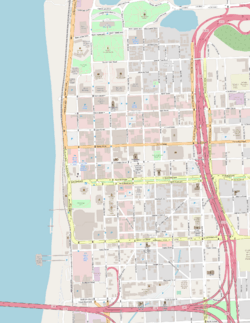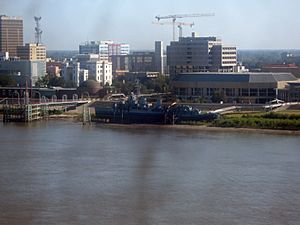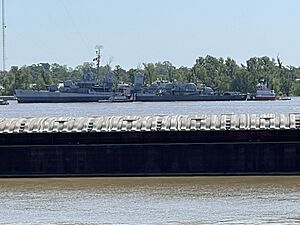USS Kidd (DD-661) facts for kids
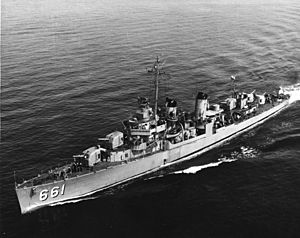
USS Kidd underway, 1951
|
|
Quick facts for kids History |
|
|---|---|
| Name | Kidd |
| Namesake | Isaac C. Kidd |
| Builder | Federal Shipbuilding and Drydock Company |
| Laid down | 16 October 1942 |
| Launched | 28 February 1943 |
| Sponsored by | Mrs. Isaac C. Kidd |
| Commissioned | 23 April 1943 |
| Decommissioned | 10 December 1946 |
| Recommissioned | 28 March 1951 |
| Decommissioned | 19 June 1964 |
| Stricken | 1 December 1974 |
| Identification | |
| Nickname(s) | Pirate of the Atlantic & Pacific |
| Honors and awards |
See Awards |
| Status | Museum ship in Baton Rouge, Louisiana |
| Badge | 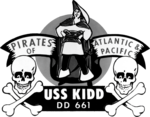 |
| General characteristics | |
| Class and type | Fletcher-class destroyer |
| Displacement | 2,050 tons |
| Length | 376 ft (115 m) |
| Beam | 39 ft 8 in (12.09 m) |
| Draft | 17 ft 9 in (5.41 m) |
| Propulsion |
|
| Speed | 35 knots (65 km/h; 40 mph) |
| Range | 6,500 nmi (12,000 km; 7,500 mi) at 15 knots (28 km/h; 17 mph) |
| Complement | 329 |
| Armament |
|
|
USS Kidd (DD-661)
|
|
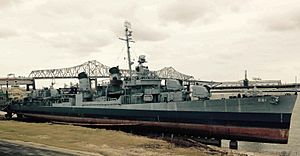
Kidd serves as part of the Louisiana Veterans Memorial.
|
|
| Location | 305 South River Road, Baton Rouge, Louisiana |
| Built | 1943 |
| Architect | US Navy |
| NRHP reference No. | 83000502 |
| Significant dates | |
| Added to NRHP | 9 August 1983 |
| Designated NHL | 14 January 1986 |
The USS Kidd (DD-661) is a famous United States Navy ship. It's a type of warship called a Fletcher-class destroyer. The ship was named after Rear Admiral Isaac C. Kidd. He was a brave admiral who died during the 1941 Japanese attack on Pearl Harbor in World War II. Admiral Kidd was the first American admiral ever killed in action.
Today, the USS Kidd is a special museum ship. It is docked on the Mississippi River in Baton Rouge, Louisiana. It's the only US destroyer left that still looks exactly like it did during World War II. The Kidd is also one of only four Fletcher-class destroyers remaining in the world. It is recognized as a National Historic Landmark.
Contents
A Ship with a Pirate Nickname
The Kidd was built by Federal Shipbuilding & Drydock Co. in New Jersey. It was launched on February 28, 1943. Mrs. Isaac C. Kidd, the admiral's widow, was the ship's sponsor. When the ship first sailed, its crew flew a Jolly Roger flag. This is a pirate flag! They even painted a pirate on the front smokestack. This is how the ship got its nickname, "Pirate of the Atlantic & Pacific."
World War II Adventures
After training, the Kidd sailed to the Pacific Ocean in August 1943. It arrived at Pearl Harbor, Hawaii, in September.
Helping at Wake Island and Rabaul
In October 1943, the Kidd helped escort aircraft carriers. These carriers launched air attacks on Japanese bases at Wake Island. Later, the ship went to Rabaul to support landings there. On November 11, Japanese planes attacked the task force. The Kidd rescued the crew of a downed plane. While doing this, it shot down three enemy aircraft and dodged bombs and torpedoes. Its commanding officer, Cmdr. Roby, received an award for his bravery.
Battles in the Pacific
The Kidd then helped protect carriers during the invasion of the Gilbert Islands. On November 24, it warned other ships about enemy bombers. It also shot down two Japanese "Val" dive bombers.
In 1944, the Kidd was busy in many battles. It helped invade the Marshall Islands by firing its guns at enemy targets. It also supported landings in New Guinea and fought in the Marianas campaign. The ship even fired its guns at Guam to help soldiers on shore.
The Philippines and Okinawa
After getting repairs, the Kidd joined a huge fleet for the invasion of the Philippines. It helped protect the first landings in Leyte Gulf in October 1944.
In 1945, the Kidd was part of the invasion of Okinawa. This was a very important battle. The ship protected larger battleships and fired at targets on shore. It also rescued pilots and helped shoot down kamikaze planes. Kamikazes were Japanese planes flown by pilots who tried to crash into enemy ships.
A Kamikaze Attack
On April 11, 1945, the Kidd and other destroyers fought off three air raids. That afternoon, an enemy plane crashed into the Kidd. This attack sadly killed 38 sailors and wounded 55. The damaged ship headed south for temporary repairs. It then sailed back to the United States for more extensive fixes. The Kidd was taken out of service on December 10, 1946.
Korean War Service
When the Korean War started, many reserve ships were called back to duty. The Kidd was one of them. It was put back into service on March 28, 1951.
Patrols and Bombardment
The destroyer sailed to Korea and joined Task Force 77. It patrolled off the Korean coast. From October 1951 to January 1952, the Kidd fired its guns at targets along the East Coast of Korea.
The Kidd returned to Korea in September 1952. It continued to patrol and bombard targets in North Korea. It stayed there during the peace talks. After its service, the ship returned to San Diego in March 1953.
An Unexpected Collision
While in Long Beach, California, in April 1953, the Kidd had an accident. A Swedish cargo ship, the Hainan, crashed into it. This meant the Kidd needed more repairs before it could sail again.
Cold War Duties
After the Korean War, the world entered the Cold War. From 1953 to 1959, the Kidd patrolled the Western Pacific. Its job was to look for Soviet submarines. It visited many places like Japan, Okinawa, Hong Kong, and the Philippines.
Training and Crisis Response
In 1960, the Kidd moved to the East Coast of the United States. It was used for Naval Reserve training cruises. In 1961, during the Berlin Crisis, it joined the active fleet. It also patrolled near the Dominican Republic in 1961 to show American presence during a time of trouble.
The Kidd took part in anti-submarine warfare (ASW) exercises in 1962. It was then assigned to the Naval Destroyer School in Newport, Rhode Island. After another cruise, it went back to training Naval Reserve sailors. The Kidd was taken out of service for the last time on June 19, 1964. It was then stored in the Philadelphia Shipyard.
A Ship Preserved
The Navy decided to save three Fletcher-class ships as memorials. The Kidd was chosen to be a memorial for Louisiana's World War II veterans. Other Fletcher-class museum ships include the USS The Sullivans in New York and the USS Cassin Young in Massachusetts.
Unique Mooring in Baton Rouge
The Kidd was towed to Baton Rouge, Louisiana, arriving on May 23, 1982. It became a museum ship and even hosts overnight camps for youth groups. The Kidd is special because it was never updated. It still looks exactly like it did in August 1945, with its original weapons.
The ship's dock in the Mississippi River is very unique. The river's depth changes a lot each year, sometimes by forty feet! For half the year, the Kidd floats on the water. For the other half, the water level drops, and the ship rests on special blocks. This means you can see its entire hull!
Recent Restoration Work
Because the Kidd rests on blocks for so long, it needs special care. In April 2024, the ship began a big journey to a shipyard in Houma, Louisiana. This was its first major preservation project since it arrived in Baton Rouge. Workers will fix its hull and upper parts. The special keel blocks that support the ship will also be improved.
Awards and Recognition
In 1986, the Kidd was named a National Historic Landmark. This was because it is the best-preserved World War II destroyer of its kind.
- Asiatic-Pacific Campaign Medal with eight battle stars
- World War II Victory Medal
- China Service Medal
- National Defense Service Medal with service star
- Korean Service Medal with four battle stars
- Armed Forces Expeditionary Medal
- Philippine Presidential Unit Citation
- Korean Presidential Unit Citation
- Philippine Liberation Medal
- United Nations Korea Medal
- Korean War Service Medal (South Korea)
See also


